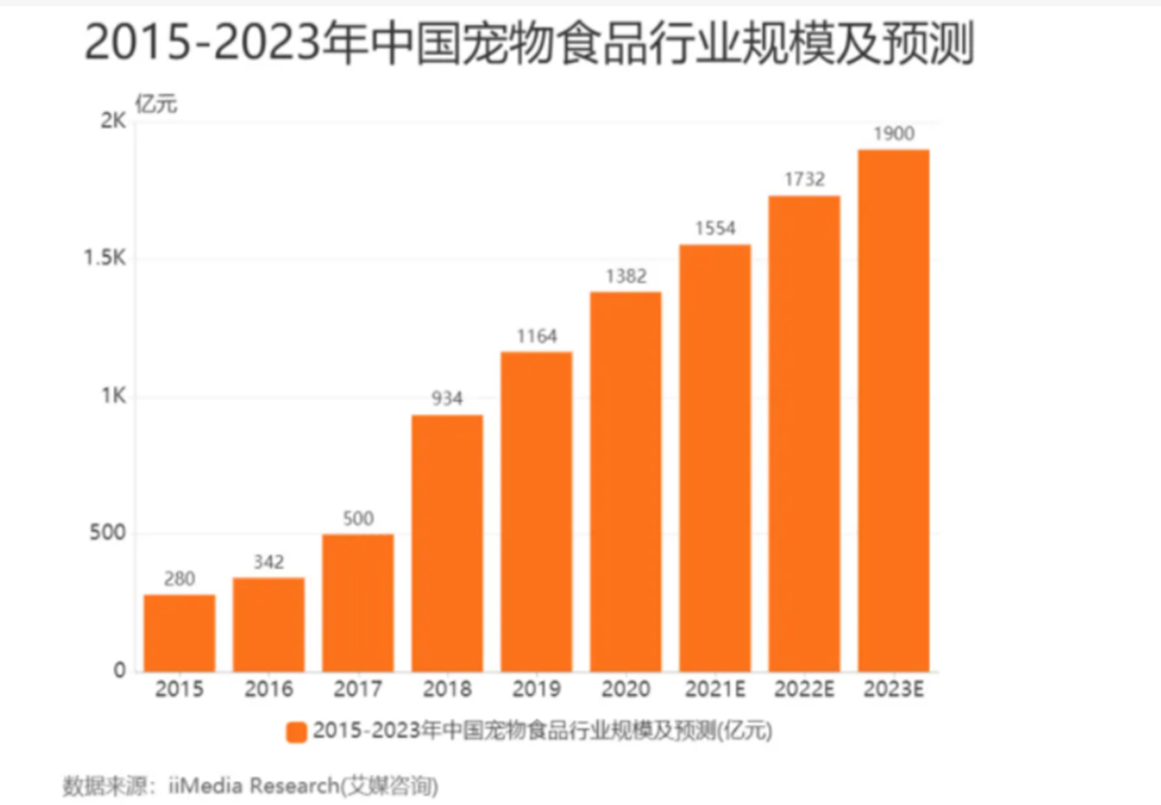Yili Cross border Pet Food Market | The 100 Billion Market Focused on by Capital Is Expected in the Future
In recent years, the pet raising group in China has been growing, and the pet economy has also been booming.
According to Ai Media, the scale of China's pet food industry will be about 155.4 billion yuan in 2021, and it is estimated that the scale of China's pet food industry will reach 173.2 billion yuan in 2022.

Such a huge market scale has also attracted a lot of capital, and Yili, a dairy giant, is one of them.
Recently, Yili, a dairy giant, announced that the enterprise will enter the 100 billion level pet food market with the brand "one on one",
It can be seen that the high-end market competition of pet food will become increasingly fierce in the future.
In fact, it is not only Yili who is eyeing this cake. As early as July 2020, three squirrels tried to cross border pet food and established the "raising a hairchild brand". In 2021, Midea, a leading household appliance enterprise, also launched the "cat food with gravity" brand.
According to the data of the Double 11 in 2020, during the Double 11, the sales of the flagship store of Tmall, a pet food brand owned by three squirrels, exceeded 2.5 million yuan, opened for 100 days, and the sales increased 90 times.
With such a huge explosive force, it is no wonder that capital is rushing in.
Epidemic environment promotes the rise of domestic brands
Careful people can actually find that the influence of overseas pet food brands on the domestic market has been weakened due to the epidemic in recent years.
However, the domestic pet market is expanding, and under the huge market demand, the domestic brands begin to rise.
In such a market environment where demand exceeds supply, many domestic capitals have been eyeing the pet market and want to share a profit from the hundred billion yuan cake.
In terms of the global market environment, North America and Europe are the main suppliers of pet food in the world.
Although China is the second largest pet food market in the world, due to the slow start of China's pet industry and the slow development of domestic pet food manufacturing industry.
For a long time in the past, the huge domestic market was occupied by imported pet food brands.
However, after 2020, the source of imported food supply chain was cut off, and the domestic high-end pet food market appeared a huge gap.
The capital smelling the benefits began to seize the market. Unlike in the past, this time, the capital paid more attention to food safety and food functionality, and the high-end market became the hot spot of capital frenzy.
From the market share of domestic high-end pet food in recent three years, the market share of domestic pet food has gradually surpassed that of imported brands.
With the emergence of more and more cross-border brands, the pet food market will no longer be covered by imported brands in the future, and the market share of domestic brands will also be higher and higher.
There is still a long way to go to break the domestic brand
Although the share of domestic brands in the domestic market has gradually increased, a large part of consumers will still choose to import pet food brands.
This is mainly because there are certain hidden dangers in domestic pet food safety.
Over the past few years, domestic brands have continuously exposed "toxic cat food" and "toxic dog food" incidents.
In 2021, when Consumer Reports sent a batch of cat food to a third-party testing agency for inspection, the total number of bacteria detected in domestic Xinyuan Development Treasure of cat food exceeded the national standard by 7.7 times.
At the beginning of 2022, the "gluttonous" cat food of Xinyuan Development Treasure caused 100 cats to get sick and die.
All these have greatly reduced the trust of pet owners in domestic brands, and they will be more cautious when buying, and will only buy when they are sure of food safety.
In terms of pet food ingredients that consumers are most concerned about, there is also a lack of more detailed standards in China.
Only in 2018 did China issue policies related to pet food for the first time, while the United States established AAFCO (American Feed Management Association) in the early 1990s to formulate detailed unified standards for pet food.
In contrast, imported products may be easier to trust consumers.
Therefore, domestic brands still need to work hard to control food safety if they want to break the situation and surpass imported brands.
Although the pet food market has a great prospect, it is not as easy to get a share as expected. The rise of domestic brands still needs efforts.


